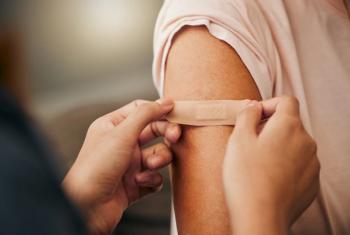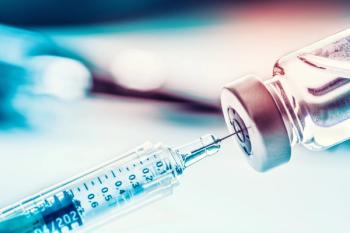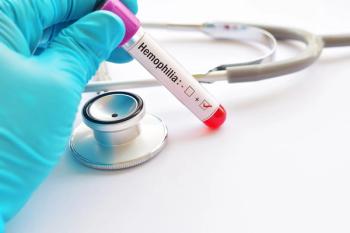
Infant RSV hospitalization rates 28%, 43% lower this season vs pre-COVID seasons
"These findings support Advisory Committee on Immunization Practices’ recommendations for maternal vaccination or nirsevimab to protect against severe RSV disease in infants," wrote the MMWR study investigators.
Surveillance data from a pair of networks revealed that respiratory syncytial virus (RSV)-associated hospitalizations among infants (0-7 months) during the 2024-2025 RSV season were estimated to be 28% and 43% lower compared to pre-COVID-19 pandemic RSV seasons, according to a new publication from the CDC's Morbidity and Mortality Weekly Report (MMWR).
In the 2024-2025 RSV season, both a maternal RSV vaccine (Abrysvo; Pfizer) and the monoclonal antibody nirsevimab (Beyfortus; Sanofi and AstraZeneca) were widely available, aiding in reduced hospitalization rates among infants. The reduced hospitalization rates align with a
Additionally, a May 1, 2025 study published in The Lancet revealed that nirsevimab is highly effective in preventing RSV-related outcomes in infants, with data analysis used from observational studies across 5 countries. These data offered the first pooled assessment of nirsevimab's effectiveness outside of clinical trials.
What's more, newer data published online by Pediatrics highlighted that 72% of infants were immunized against RSV, based on a total of 36,949 eligible infants from 43,722 pregnancies. These data were from 10 Vaccine Safety Datalink health systems in addition to electronic health records that determined RSV vaccination4
2024-2025 RSV rates vs pre-COVID rates
According to MMWR, evaluation of the association between availability of the vaccine and nirsevimab, and infant and child RSV-associated hospitalizations was based on data from the RSV-Associated Hospitalization Surveillance Network (RSV-NET) and New Vaccine Surveillance Network (NVSN).1
Among infants aged 0-7 months, ages for which they are eligible for protection with maternal vaccination or nirsevimab, rates in 2024-2025 were 43% lower vs 2018-2020 pooled rates for the RSV-NET group (95% CI = 40%–46%). NVSN data revealed a 28% reduction in hospitalization rates between the same time periods (95% CI = 18%–36%).
Infants aged 0-2 months observed the largest estimated rate reduction during peak hospitalization periods, from December to February. In the RSV-NET data, there was a 52% rate reduction (95% CI = 49%–56%) and a 45% rate reduction in the NVSN (95% CI = 32%–57%).
"These findings support Advisory Committee on Immunization Practices’ recommendations for maternal vaccination or nirsevimab to protect against severe RSV disease in infants," wrote the MMWR study investigators. "[These findings] highlight the importance of implementing the recommendations to protect infants as early in the RSV season as possible, before peak transmission, and for infants born during the RSV season, within the first week of life, ideally during the birth hospitalization," they added.
More RSV coverage
RSV prophylaxis: Palivizumab, nirsevimab, and more
Published in our May issue of Contemporary Pediatrics, Noah Christian, MD and Joseph Collaco, MD, PhD, detailed a complete feature article on RSV prophylaxis.
2025 immunization update recap with Mary Koslap-Petraco, DNP
At the 2025 NAPNAP National Conference on Pediatric Health Care in Chicago, Mary Koslap-Petraco, DNP, PPCNP-BC, CPNP, FAANP, chair of the Scientific Advisory Board for Vaccinate Your Family and clinical assistant professor at Stony Brook University, provided updates on immunizations for pediatric patients. Her session covered key changes to influenza, COVID-19, and respiratory syncytial virus (RSV) vaccines, along with guidance on improving vaccine uptake among families.
References:
1. Patton ME, Moline HL, Whitaker M, et al. Interim evaluation of respiratory syncytial virus hospitalization rates among infants and young children after introduction of respiratory syncytial virus prevention products — United States, October 2024–February 2025. MMWR Morb Mortal Wkly Rep. 2025;74. doi:10.15585/mmwr.mm7416a1
2. Fitch J. RSV prevention strategies show high uptake, positive outcomes. Contemporary Pediatrics.February 20, 2025. Accessed May 9, 2025. https://www.contemporarypediatrics.com/view/rsv-prevention-strategies-show-high-uptake-positive-outcomes
3. Ebert M. Nirsevimab shows strong real-world effectiveness against RSV in infants. Contemporary Pediatrics. May 1, 2025. Accessed May 9, 2025. https://www.contemporarypediatrics.com/view/nirsevimab-shows-strong-real-world-effectiveness-against-rsv-in-infants
4. Irving SA, Crane B, Weintraub ES, et al. Infant Respiratory Syncytial Virus Immunization Coverage in the Vaccine Safety Datalink: 2023–2024. Pediatrics 2025; e2024070240. 10.1542/peds.2024-070240
Newsletter
Access practical, evidence-based guidance to support better care for our youngest patients. Join our email list for the latest clinical updates.











